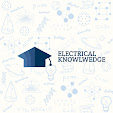SOLAR ENERGY { COMPONENTS OF SOLAR ELECTRIC SYSTEM}
solar energy
Components of a Solar Electric System

Solar panels
The heart of a solar electric system is the solar panel itself.
There are various types of solar panels and I will describe them all in detail
later on. Solar panels or, more accurately, photovoltaic solar panels, generate
electricity from the sun. The more powerful the sun’s energy, the more power
you get, although solar panels continue to generate small amounts of
electricity in the shade.
Most solar panels are made up of individual solar cells, connected
together. A typical solar cell will only produce around half a volt, so by
connecting them together in series inside the panel, a more useful voltage is
achieved. Most solar panels are rated as 12-volt solar panels, although
higher-voltage panels are also available. A 12-volt solar panel produces around
14–18 volts when put under load. This allows a single solar panel to charge up a
12-volt battery.
Incidentally, if you connect a voltmeter up to a solar panel when it
is not under load, you may well see voltage readings of up to 26 volts. This is
normal in an ‘open circuit’ on a solar panel. As soon as you connect the solar
panel into a circuit, this voltage level will drop to around 14–18 volts.
Connecting the panels in series allows a solar array to run at a
higher voltage. Typically, 24 volts or 48 volts in a stand-alone system, or up
to several hundred volts in a grid-tie system.
Connecting the panels in parallel allows a solar array to produce
more power while maintaining the same voltage as the individual panel.
Batteries
Except in a grid-tie system, where the solar array connects directly
to an inverter, solar panels rarely power electrical equipment directly. This
is because the amount of power the solar panel collects varies depending on the
strength of sunlight. This makes the power source too variable for most
electrical equipment to cope. In a grid-tie system, the inverter handles this
variability: if demand outstrips supply, you will get power from both the grid
and your solar system. For a stand-alone or a grid fallback system, batteries store the energy and provide a constant
power source for your electrical equipment.
Most lead-acid batteries are 6-volt or 12-volt batteries and, like
solar panels, these can be connected together to form a larger battery bank.
Like solar panels, multiple batteries used in series increase the capacity and
the voltage of a battery bank. Multiple batteries connected in parallel
increase the capacity whilst keeping the voltage the same.
ControlleR
If you are using batteries, your solar electric system is going to require a controller in order to manage the flow of electricity (the current) into and out of the battery. If your system overcharges the batteries, this will damage and eventually destroy them. Likewise, if your system completely discharges the batteries, this will quite rapidly destroy them. A solar controller prevents this from happening. There are a few instances where a small solar electric system does not require a controller. An example of this is a small ‘battery top-up’ solar panel that is used to keep a car battery in peak condition when the car is not being used. These solar panels are too small to damage the battery when the battery is fully charged.
Inverter
The electricity generated by a solar electric system is direct
current (DC). Electricity from the grid is high-voltage alternating current
(AC). Traditionally, there is usually one central inverter in a solar system,
either connecting directly to the solar array in a grid-tie system, or to the
battery pack in an off-grid system. A more recent invention has been the microinverter. Micro-inverters are connected to individual solar panels so that each
individual panel provides a high-voltage alternating current.
Solar panels with micro-inverters are typically only used with
grid-tie systems and are not suitable for systems with battery backup. For
grid-tie systems, they do offer some significant benefits over the more
traditional ‘big box’ inverter, although the up-front cost is currently higher.
Electrical devices
The final element of your solar electric system is the devices you
plan to power.
Low-voltage device
Most off-grid solar systems run at low voltages. Unless you are
planning a pure grid-tie installation, you may wish to consider running at
least some of your devices directly from your DC supply rather than running
everything through an inverter. This has the benefit of greater efficiency.
You can also charge up most portable items such as MP3 players and
mobile phones from a 12-volt supply.
High-voltage devices
If running everything at low voltage is not an option, or if you are
using a grid[1]tie the system, you use an inverter to run your electrical devices


No comments:
If you have any doubts, please let me know